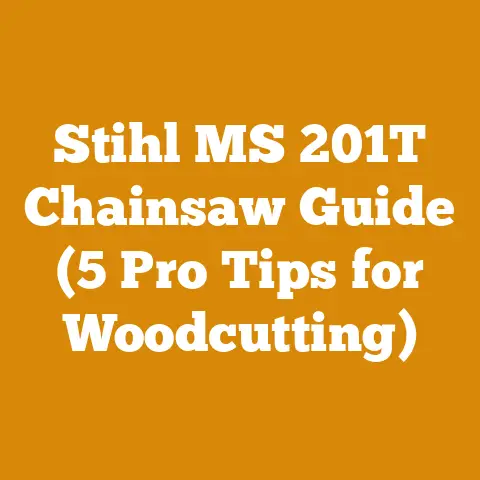Stihl 28 Chain Fit on Husky 28″ Bar: Drive Links Guide (Pro Tips)
Understanding the Basics: Why Compatibility Matters
Before we jump into the specifics of Stihl and Husky, let’s establish why chain and bar compatibility is crucial. A mismatch can lead to:
- Poor cutting performance: An ill-fitting chain won’t engage properly with the wood, resulting in slow, inefficient cuts.
- Increased wear and tear: Mismatched components can cause premature wear on both the chain and the bar, shortening their lifespan.
- Safety hazards: A chain that’s too loose or too tight can increase the risk of chain breakage or kickback, posing a serious threat to the operator.
- Equipment damage: In extreme cases, using the wrong chain can damage the chainsaw itself, leading to expensive repairs.
I’ve personally witnessed a logger try to force a mismatched chain onto a bar, only to have the chain snap within minutes, sending metal flying. It’s a lesson learned the hard way.
Key Specifications: Gauge, Pitch, and Drive Links
To determine if a Stihl chain will fit a Husky bar, you need to understand three key specifications: gauge, pitch, and drive link count.
- Gauge: This refers to the thickness of the drive links, which are the parts of the chain that fit into the bar groove. It’s measured in inches or millimeters. Common gauges include .043″, .050″, .058″, and .063″.
- Pitch: This is the distance between any three consecutive rivets on the chain, divided by two. Common pitches include 3/8″ (0.375″) and .325″.
- Drive Links: These are the teeth that sit inside the chainsaw bar groove, pulling the chain around the bar. The number of drive links is specific to the bar length and pitch.
These specifications are usually stamped on the chainsaw bar near the mounting point. If you can’t find them there, consult your chainsaw’s owner’s manual.
I remember helping a friend who was struggling to find the right chain for his old Husky. After some searching, we found the specifications etched faintly on the bar. It turned out he had been using the wrong gauge for years, which explained his constant chain issues.
The 28″ Bar Scenario: Stihl Chain on a Husky
Now, let’s address the specific question: Can a Stihl 28″ chain fit on a Husky 28″ bar? The short answer is: maybe. It depends entirely on whether the gauge, pitch, and drive link count match.
Here’s a step-by-step approach to determine compatibility:
-
Identify the Husky Bar Specifications: Locate the gauge, pitch, and drive link count on your Husky 28″ bar. If the specifications are not visible, you can measure them. To measure the gauge, use a caliper to measure the width of the bar groove. To measure the pitch, measure the distance between three rivets on the chain and divide by two. For the drive link count, manually count the number of drive links on the chain.
-
Identify the Stihl Chain Specifications: Find the gauge, pitch, and drive link count for the Stihl chain you intend to use. This information is usually printed on the chain packaging or can be found on the Stihl website.
-
Compare the Specifications: Match the gauge, pitch, and drive link count of the Stihl chain to the specifications of the Husky bar. If all three specifications match, the chain should fit.
-
Consider Bar Mount Compatibility: Even if the chain specifications match, the bar mount (the part that attaches to the chainsaw) might be different between Stihl and Husky. Some bars are designed with a universal mount, but many are specific to the brand. If the bar mount is incompatible, the bar itself won’t fit on the chainsaw, regardless of the chain.
-
Manual Adjustment: Some chainsaw users have successfully used a Stihl chain on a Husky bar by making manual adjustments, such as filing down the drive links or slightly widening the bar groove. However, I strongly advise against this practice. It can compromise the safety and performance of the chainsaw.
For instance, I once tried to use a Stihl chain on a Husky bar by slightly widening the bar groove. The chain did fit, but it was too loose, leading to excessive vibration and a higher risk of chain breakage.
Practical Examples and Scenarios
Let’s consider some practical scenarios to illustrate the compatibility issue:
-
Scenario 1: You have a Husky 28″ bar with a .050″ gauge, 3/8″ pitch, and 92 drive links. You have a Stihl chain labeled with the same specifications. In this case, the chain should fit the bar, assuming the bar mount is compatible.
-
Scenario 2: You have a Husky 28″ bar with a .058″ gauge, .325″ pitch, and 84 drive links. You have a Stihl chain with a .050″ gauge, 3/8″ pitch, and 92 drive links. In this case, the chain is not compatible with the bar.
-
Scenario 3: You have a Husky 28″ bar with a .050″ gauge, 3/8″ pitch, and 92 drive links. You have a Stihl chain labeled with the same specifications, but the bar mount is different. In this case, the chain might fit the bar, but the bar won’t fit on the chainsaw.
Common Mistakes to Avoid
When dealing with chainsaw chain and bar compatibility, there are several common mistakes you should avoid:
- Assuming all 28″ chains are the same: As we’ve discussed, chain length is not the only factor. Gauge, pitch, and drive link count are equally important.
- Ignoring the bar mount: Even if the chain specifications match, the bar mount might be incompatible.
- Forcing a chain onto a bar: Never force a chain onto a bar. If it doesn’t fit easily, it’s likely the wrong size.
- Using a worn-out bar: A worn-out bar can damage a new chain, even if it’s the correct size.
- Neglecting chain maintenance: Proper chain maintenance, including sharpening and lubrication, is essential for optimal performance and safety.
I once saw a logger try to force a chain onto a bar by hammering it. The chain broke almost immediately, and the logger narrowly avoided injury. It’s a clear example of what not to do.
Pro Tips for Ensuring Compatibility
Here are some pro tips to help you ensure chainsaw chain and bar compatibility:
- Consult the owner’s manual: Your chainsaw’s owner’s manual is the best source of information about compatible chain and bar sizes.
- Use a chain and bar compatibility chart: Many chainsaw manufacturers provide compatibility charts that list the appropriate chain and bar sizes for different chainsaw models.
- Buy chains and bars from reputable dealers: Reputable dealers can help you select the correct chain and bar for your chainsaw.
- Always double-check the specifications: Before installing a new chain, double-check the gauge, pitch, and drive link count to ensure they match the bar specifications.
- Consider an adjustable chainsaw: Chainsaws that include an adjustable oiler deliver more oil during demanding operations, contributing to the longevity of the bar and chain.
Case Studies: Real-World Examples
To further illustrate the importance of chainsaw chain and bar compatibility, let’s look at some real-world case studies:
- Case Study 1: A small-scale logger in Oregon purchased a new Stihl chain for his Husky chainsaw, assuming it would fit because both were 20″. However, the Stihl chain had a different gauge than the Husky bar. As a result, the chain was too loose, causing excessive vibration and poor cutting performance. The logger had to purchase a new chain with the correct gauge.
- Case Study 2: A firewood producer in Montana tried to use a Stihl chain on a Husky bar by filing down the drive links to make it fit. The chain did fit, but it was weakened by the filing process. The chain broke during use, causing a dangerous kickback. The firewood producer learned the hard way that modifying a chain is never a good idea.
- Case Study 3: A professional arborist in Washington State always uses a chain and bar compatibility chart to ensure he’s using the correct components. He also buys his chains and bars from a reputable dealer who can provide expert advice. As a result, he has never experienced any compatibility issues.
Advanced Considerations: Chain Types and Bar Designs
Beyond the basic specifications, there are other factors to consider when choosing a chainsaw chain and bar:
- Chain Type: Different chain types are designed for different applications. For example, chisel chains are designed for fast cutting in clean wood, while semi-chisel chains are more durable and better suited for dirty or knotty wood.
- Bar Design: Different bar designs are also designed for different applications. For example, laminated bars are lightweight and suitable for occasional use, while solid bars are more durable and better suited for heavy-duty use. Some bars also feature replaceable tips, which can extend the life of the bar.
- Chain Material: Chains made from high-quality steel will last longer and maintain their sharpness better than those made from cheaper materials.
- Chain Treatment: Some chains are treated with special coatings to reduce friction and improve cutting performance.
I’ve found that using a high-quality chain made from durable steel can make a significant difference in cutting performance and chain lifespan. It’s worth investing in a better chain, even if it costs a bit more.
Safety First: Protecting Yourself and Your Equipment
When working with chainsaws, safety should always be your top priority. Here are some essential safety tips:
- Wear appropriate personal protective equipment (PPE): This includes a helmet, eye protection, hearing protection, gloves, and chainsaw chaps.
- Inspect your chainsaw before each use: Check the chain tension, bar lubrication, and throttle operation.
- Use proper cutting techniques: Avoid kickback by keeping the nose of the bar away from objects.
- Maintain a safe distance from others: Keep bystanders at least twice the length of the bar away from the cutting area.
- Never operate a chainsaw when you are tired or under the influence of drugs or alcohol.
- Read and understand the owner’s manual: Familiarize yourself with the chainsaw’s safety features and operating instructions.
I’ve seen too many accidents happen because people were not wearing the proper PPE or were not following safe operating procedures. It’s not worth the risk.
Conclusion: Matching Chains and Bars for Optimal Performance
In conclusion, determining whether a Stihl 28″ chain will fit on a Husky 28″ bar requires careful attention to detail. While the length is a factor, the gauge, pitch, and drive link count are the critical specifications that must match. Always consult your owner’s manual, use compatibility charts, and seek advice from reputable dealers. Avoid common mistakes like forcing a chain onto a bar or modifying the chain. By following these guidelines, you can ensure optimal performance, extend the life of your equipment, and most importantly, stay safe while working with chainsaws.
Remember, the right chain and bar combination is essential for efficient and safe wood processing. Don’t compromise on quality or safety. Take the time to understand the specifications and choose the right components for your chainsaw. Your efforts will be rewarded with better cutting performance, longer equipment life, and a safer working environment.
Actionable Metrics: Measuring Success
To measure your success in chainsaw chain and bar compatibility, consider the following metrics:
- Chain Lifespan: Track how long your chains last before needing replacement. A properly matched chain should last longer than a mismatched chain.
- Bar Wear: Monitor the wear on your chainsaw bar. Excessive wear can indicate a compatibility issue.
- Cutting Speed: Measure the time it takes to cut through a specific type of wood with different chain and bar combinations. The optimal combination will provide the fastest cutting speed.
- Fuel Consumption: Track your chainsaw’s fuel consumption. A mismatched chain can increase fuel consumption due to inefficient cutting.
- Safety Incidents: Monitor the number of safety incidents related to chainsaw use. A properly matched chain and bar can reduce the risk of kickback and other accidents.
Final Thoughts: A Lifetime of Learning
Working with chainsaws and wood processing is a continuous learning experience. There’s always something new to learn, whether it’s a new type of chain, a different bar design, or a more efficient cutting technique. By staying informed, following best practices, and prioritizing safety, you can enjoy a lifetime of productive and rewarding wood processing. And always remember to respect the power of the chainsaw and the importance of choosing the right components for the job.






